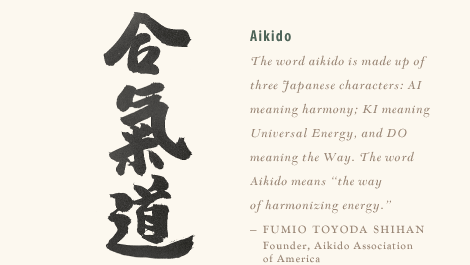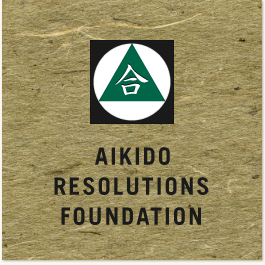Aikido Terms
Ai Meeting, joining, harmony
Aikido The way of being one with energy
Ai hanmi Mutually agreeing stance (both uke and nage lead with same foot
Aikidoka Person who practices Aikido
Aikitaiso Mind-body coordination exercises
Atemi Strikes, used as a part of Aikido technique
Awase Meeting or coming together
Ayumi ashi Normal stepping, as in walking
Bo Wooden staff, usually 72”
Bokken Wooden sword
Bokken dori Sword-taking technique; also called tachitori
Bokuto Wooden sword
Bu Martial
Budo Martial way
Budoka A practitioner of budo
Bushi Warrior class
Bushido Way of the warrior
Butsudan “Buddha shelf;” a Buddhist shrine, often placed at the front of a dojo influenced
by Buddhist tradition
Cho Chief or head, as in dojo-cho
Chudan Middle position
Dame Incorrect, bad
Dan Black belt ranks
Do Way or path, same word as the Chinese Tao
Dogi Training uniform
Dojo Place of enlightenment; training hall
Doshu Master of the way; currently Kisshomaru Ueshiba
Eri Collar
Fudo Immovable; e.g. fudoshin, immovable mind; fudo no shisei, immovable posture
Gaeshi Reversal
Ganmenuchi Thrust to the face
Gedan Low position
Gi Training uniform
Giri Obligation to another
Gokyo Fifth teaching; an elbow-locking technique
Gyaku Reverse or opposite
Gyaku hanmi Mutually opposite stance (nage and uke lead with different feet)
Hakama Divided skirt
Hanmi Half-body stanc
Hantachi Half-standing (kneeling position)
Hanmi hantachi waza Techniques performed by a kneeling nage against standing uke
Hantai Opposite or reverse
Hara The lower abdomen; the seat of correct breathing and of internal power
Hasso A stance with the bokken or jo held to one side of the head, extending up from
the shoulder
Heiho Strategy, martial science
Henka waza “Changing technique;” changing from one technique to another
Hidari Left
Hiji Elbow
Hitai Forehead
Hito e mi One layer of the body; a description of distance relative to an opponent
Hiza Knee
Ho Method
Hoho Cheek
Hombu Headquarters
Ii Good
Iie No
Ikkyo First teaching; an arm-controlling technique
Irimi Entering
Iriminage Entering throw
Isshin den shin From mind to mind; the way in which knowledge is said to be transmitted from teacher to pupil
Jiyu Free (as in free technique)
Jo Short wooden staff (usually 50”)
Jodan Upper position
Jo dori Jo-taking technique
Jo nage Throwing with the jo
Joseki Upper (senior) side of mat area; facing shomen, joseki is the right side
Joza Upper seat, where the instructor sits
Jiujinage Crossed-arms throw; literally "number-ten" throw, referencing the cruciform shape of that character in Chinese writing
Kaeshi waza Counter technique; applying a technique against the person attempting to apply one to you.
Kaiso Founder
Kaitenage Rotary throw
Kakari geiko Group practice
Kamae Stance or position
Kami Diety, spirit, divine being; a Shinto term
Kamiza “God seat;” shrine or front of the dojo, if Shinto-influenced
Kan House or hall; also romanized this way is a different word meaning intuition
Kata Shoulder; also, a different word meaning a form used in training; e.g. bokken kata
Katatori Grasping the shoulder or lapel
Katate Forearm area
Katate ryotetori One wrist grasped by both hands
Katame waza Pinning technique
Katana A type of long sword, worn edge upwards
Ken Sword
Kenshusei “Student who strives for mastery through polishing;” in the Association, students committed to a more intense study of Aikido
Ki Spirit, vital force, energy
Kiai Explosive projection of energy in the form of a shout or yell; also refers to the general energy level of a person or thing
Kihon Basic technique
Ki musubi Linking one’s energy with that of the opponent
Kiri Cut
Kirigaeshi A suburi exercise of continuous yokomen and gyaku yokomen strikes
Kohai Junior
Kotai Movement to the rear
Kote Forearm or wrist
Kotegaeshi “Wrist-turning;” a throwing technique
Kokyu Animating breath; also used to imply timing
Kokyudosa Breath or timing exercise
Koshi Hip
Koshinage Hip throw
Kuden Oral instruction
Kubi Neck
Kubishime Choking the neck
Kumitachi Sword against sword
Kumijo Jo against jo
Kyu Ranks below dan grade
Ma-ai Distance
Mae Front or forward
Meiso ho Meditation exercise
Men Head
Migi Right
Misogi Purification practices; often refers specifically to a breathing technique
Morote tori See Katate ryotetori
Mune Chest
Mune tsuki Thrust to the chest
Mushin “No-mind;” a state of mind free from obstruction or attachment to thoughts
or happenings
Nage Throw; also, the person executing the throw
Nikyo Second teaching
No An article indicating possession or connection; e.g. chudan no kamae: “stance of middle position”
Ni A directional indicator; e.g. shomen ni rei: “bow to the front”
Obi Belt
Omote Front
Orenaite Unbendable arm
Osae Pin; e.g. ude osae: arm pin
O’Sensei “Venerable teacher;” refers in Aikido to Morihei Ueshiba
Oyo waza Advanced or applied technique
Randori Multiple person attack (lit. “seizing chaos”)
Rei Bow
Ritsurei Standing bow
Ryote Both hands
Ryotetori Grasping both hands
San Suffix, expression of respect
Sankakutai Triangular stance
Sankyo Third teaching
Sayu Side
Seika no itten The “one point;” see tanden
Seiza Formal kneeling position
Sempai Senior
Sensei Instructor (lit. “born before”)
Shikko Walking on the knees
Shihan Teacher of teachers
Shihonage Four corner throw
Shime Choking or strangling
Shimoza Lower seat; place where students sit; the wall opposite from kamiza or shomen
Shimoseki Junior area of mat; facing shomen, the left side
Shinken Alive, steel sword; figuratively, implies seriousness and commitment
Shinken shobu A fight to the death; figuratively, implies a situation requiring total abandon and concentration. The spirit of good practice should be shinken shobu.
Shinto The native Japanese religion
Shisei Posture, body alignment
Shomen Front; the wall towards which students bow
Shomenuchi Overhaed strike to the font ofthe head
Shugyo Intense physical/ internal training to perfect character and realize one’s true nature
Shuto Cutting strike with the edge of the hand
Sokumen iriminage Side of the head entering throw
Suburi “Empty swing;” individual striking practice with a weapon
Suburito A heavy bokken used for suburi, and sometimes for kumitachi
Sumi otoshi Corner drop, a throwing technique
Suki Opening or weakness, mental or physical, in an opponent’s defenses
Suriashi Sliding foot
Suwari waza Technique with both uke and nage in kneeling position
Tachi A type of long sword; technically refers to swords worn edge downward
Tachitori See Bokken dori
Taijutsu Unarmed body arts
Tai sabaki Body movement; e.g. irimi, tenkan
Tanden (Chinese: tan tien); the “one point,” the center of the body’s gravity and source of spiritual power, located two inches below the navel in the center of the hara
Tanto Knife
Tanto dori Knife-taking techniques
Tatami Mat
Tegatana ”Hand sword;” the manner in which the arm and hands are used in Aikido to move and strike
Tekubi Wrist (lit. “throat of the hand”)
Tekubitori Wrist grab
Tenkan “Spinning change;” a turning body movement
Tenchinage “Heaven-and-earth throw”
To Sword; also, the article “and”
Tori To grab or seize; also, the nage or defender
Toshu Without a weapon
Tsuba Sword hilt
Tsuki Thrusting attack, with fist or weapon
Uchi Strike
Uchideshi ”Inner disciple;” students living in a dojo and committed to full-time training,
24 hours a day
Ude Arm
Ude garami Arm-entwining technique
Uke One who is thrown (lit. “one who receives”)
Ukemi “Receiving body;” the art of falling and receiving techniques without injury
Undo Exercise
Ura Behind
Ushiro From behind or rear
Ushirotori Any rear attack; often refers specifically to bearhug. Other rear attacks include ushiroeridori, ushirotekubitori, ushirokubishime, ushirohijitori, ushirokatatori, etc.
Waza Technique
Yame Stop (a command)
Yoko Side
Yokomenuchi A strike to the side of the head or temple
Yonkyo Fourth teaching
Yubi Fingers
Zanshin “Remaining mind;” a continued extension of concentration, energy and awareness at the conclusion of a technique and immediately afterward; the “follow through” of the technique
Zen (Sanskrit: “Dhyana”; Chinese “Ch’an”); literally “meditation;” a school of Buddhism emphasizing personal, intuitive experience of reality, and having a strong influence on Japanese thought and the martial arts
Zori Sandals
[ Top ]
|




